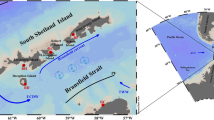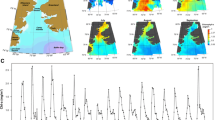Abstract
The development of the phytoplankton bloom and its relation to water column stabilisation during the transition from early to high summer (of 1991) in the seasonally ice-covered zone of the Barents Sea were studied from a meridional transect of repeated hydrographic/biological stations. The water column stabilisation is described in detail with the aid of vertical profiles of the Brunt-Väisälä frequency squared (N2). The contributions of seasonal warming and ice melting to stabilisation are elucidated by determining the effects of temperature and salinity on N2. The spring bloom in 1991 migrated poleward from June to July by about 400 km, associated with the retreat of the ice edge. The spring bloom culminated with maximum chlorophyll concentrations in the mixed layer about 100–300 km north of the centre of the meltwater lens, at its northern edge, where the ice cover was still substantial. From the distribution of N2 it becomes obvious that the bloom starts at the very beginning of stabilisation, which results solely from the release of meltwater. The increase in temperature due to the seasonal warming does not contribute to the onset of vernal blooming; temperature starts to contribute to the stratification later, when the spring bloom has ceased due to the exhaustion of nutrients in the mixed layer. By that time a deep chlorophyll maximum has formed in the seasonal pycnocline, 20–30 m below the base of the mixed layer. The effect of the seasonal ice cover on the mean areal new primary production is discussed.
Similar content being viewed by others
References
Dugdale RC, Goering JJ (1967) Uptake of new and regenerated forms of nitrogen in primary production. Limnol Oceanogr 12:196–206
Eppley RW, Petersen BJ (1979) Particulate organic matter flux and planktonic new production in the deep ocean. Nature 282:677–680
Evans CA, O’Reily JE (1987) A handbook for the measurement of chlorophylla in netplankton and nanoplankton. BIOMASS Handb 9: 1–14
Glover DM, Brewer PG (1988) Estimates of wintertime mixed layer nutrient concentrations in the North Atlantic. Deep-Sea Res 35:1525–1546
Inall M, Parker P (1992) Sea ice. In: Rachor E (ed) Scientific cruise report of the 1991 Arctic expedition ARK VIII/2 of RV “Polarstern”. Ber Polarforsch 115:43–50
Loeng H (1991) Features of the physical oceanographic conditions of the Barents Sea. In: Sakshaug E, Hopkins CCE, Øritsland NA (eds) Proceedings of the Pro Mare Symposium on Polar Marine Ecology. Polar Res 10:5–18
Luchetta A, Civitarese G, Matishov D (1992) Hydrochemistry. In: Rachor E (ed) Scientific cruise report of the 1991 Arctic expedition ARK VIII/2 of RV “Polarstern”. Ber Polarforsch 115:32–42
Millard RC, Owens WB, Fofonoff NP (1990) On the calculation of the Brunt-Väisälä frequency. Deep-Sea Res 37:167–181
Mitchell BG, Brody EA, Yeh E-N, McClain C, Comiso JC, Maynard NG (1991) Meridional zonation of the Barents Sea ecosystem inferred from satellite remote sensing and in situ bio-optical observations. In: Sakshaug E, Hopkins CCE, Øritsland NA (eds) Proceedings of the Pro Mare Symposium on Polar Marine Ecology. Polar Res 10:147–162
Rachor E, with contributions of the participants (1992) Scientific cruise report of the 1991 Arctic expedition ARK VIII/2 of RV “Polarstern”. Ber Polarforsch 115
Redfield AC, Ketchum BH, Richards FA (1963) The influence of organisms on the composition of sea-water. In: Hill MN (ed) The sea, vol 2. Wiley, New York, pp 26–77
Rey F, Loeng H (1985) The influence of ice and hydrographic conditions on the development of phytoplankton in the Barents Sea. In: Gray JS, Christiansen ME (eds) Marine biology of polar regions and effects of stress on marine organisms, Proc 18th Europ Mar Biol Symp. Wiley, Chichester, pp 49–63
Rey F, Skjoldal HR, Slagstad D (1987) Primary production in relation to climatic changes in the Barents Sea. In: Loeng H (ed) The effects of oceanographic conditions on the distribution and population dynamics of commercial fish stocks in the Barents Sea, Proc 3rd Soviet-Norwegian Symposium. Institute of Marine Research, Bergen, pp 29–46
Sakshaug E, Skjoldal HR (1989) Life at the ice edge. Ambio 18:60–67
Sakshaug E, Slagstad D (1992) Sea ice and wind: effects on primary productivity in the Barents Sea. Atmos Ocean 30:579–591
Sakshaug E, Hopkins CCE, Øritsland NA (eds) (1991) Proceedings of the Pro Mare Symposium on Polar Marine Ecology, Trondheim, Norway. Polar Res 10
Skjoldal HR, Rey F (1989) Pelagic production and variability of the Barents Sea ecosystem. In: Sherman K, Alexander LM (eds) Biomass yields and geography of large marine ecosystems. AAAS Selected Symposium, West View Press, Boulder, Colorado 111: pp 241–286
Skjoldal HR, Hassel A, Rey F, Loeng H (1987) Spring bloom development and zooplankton reproduction in the central Barents Sea in the period 1979–1984. In: Loeng H (ed) The effects of oceanographic conditions on the distribution and population dynamics of commercial fish stocks in the Barents Sea, Proc 3rd Soviet-Norwegian Symposium. Institute of Marine Research, Bergen, Norway, pp 59–89
Slagstad D, Støle-Hansen K (1991) Dynamics of plankton growth in the Barents Sea: model studies. In: Sakshaug E, Hopkins CCE, Øritsland NA (eds) Proceedings of the Pro Mare Symposium on Polar Marine Ecology. Polar Res 10:173–186
Smith WO Jr (1987) Phytoplankton dynamics in marginal ice zones. Oceanogr Mar Biol Annu Rev 25:11–38
Strass VH (1990) On the calibration of large-scale fluorometric chlorophyll measurements from towed undulating vehicles. Deep-Sea Res 37:525–540
Strass VH, Woods JD (1991) New production in the summer revealed by the meridional slope of the deep chlorophyll maximum. Deep-Sea Res 38:35–56
Sverdrup HU (1953) On conditions for the vernal blooming of phytoplankton. J (Cons) Cons Perm Int Explor Mer 18:287–295
Wassmann P, Slagstad D (1993) Seasonal and annual dynamics of carbon flux in the Barents Sea — a model approach. Polar Biol 13:363–372
Wolf K-U, Woods JD (1988) Lagrangian simulation of primary production in the physical environment — the deep chlorophyll maximum and nutricline. In: Rothschild BJ (ed) Toward a theory on biological-physical interactions in the World Ocean. Kluwer, Dordrecht, The Netherlands, pp 51–70
Woods JD, Barkmann W (1986) The response of the upper ocean to solar heating. I. The mixed layer. Q J R Meteorol Soc: 112:1–27
Author information
Authors and Affiliations
Additional information
The data presented were collected during the European “Polarstern” Study (Arctic EPOS) sponsored by the European Science Foundation
Rights and permissions
About this article
Cite this article
Strass, V.H., Nöthig, E.M. Seasonal shifts in ice edge phytoplankton blooms in the Barents Sea related to the water column stability. Polar Biol 16, 409–422 (1996). https://doi.org/10.1007/BF02390423
Received:
Accepted:
Issue Date:
DOI: https://doi.org/10.1007/BF02390423




